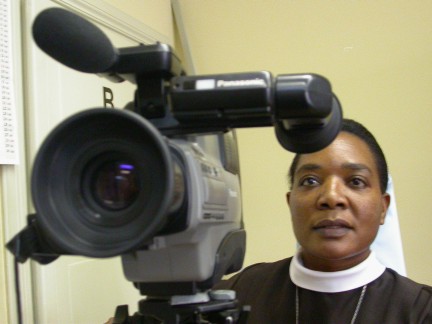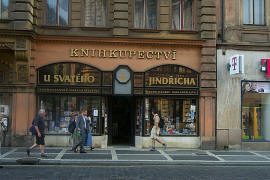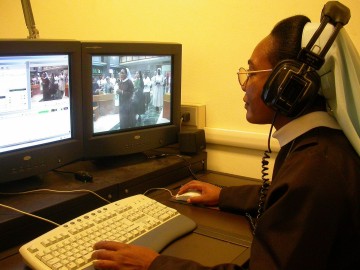|
no. 1 january - march 2005
Working to Communicate God’s Word in 2005 Our use of the modern means of communication for evangelization C ommunication – the exchange of information remains a key ingredient in all that we do as Carmelites. It allows for us to have community life. It is what we do when we minister. It is another word for prayer.The places we live and work speak loudly about who we are. The art hanging on the walls, the windows in our chapels and churches, the furnishings in our rooms, the way we dress, and our language are just a few of the informal ways we communicate—indicators of what beliefs we hold to anyone who might meet us. The entrance to each monastery says much about what goes on behind the door. In fact, the wall that surrounds many of our houses is a forceful communication to those outside— hopefully "a visible sign of the Church which contemplates the Lord." (Nuns Constitutions, 59)Throughout its history, the Church has used the available means of
communication to carry out its mission. The Second Vatican Council, in its
Decree on the Media of Social Communication, Inter Mirifica,
outlined its clear understanding of the power of good communication and
the necessity for the Church to continue to develop in this area. The Church, our mother, knows that these means of social communication, if properly utilized, can be of great service to people, since they greatly contribute to one’s entertainment and instruction as well as to the spread and support of the Kingdom of God. The Church recognizes, too, that we can employ these media contrary to the plan of the Creator and to their own loss. Indeed, the Church experiences maternal grief at the harm all too often done to society by their evil use. (Inter Mirifica, 2)
The Carmelite Constitutions identify three ideas necessary for authentic community modeled on the Jerusalem Community: self-emptying, centered in God, and charismatic/prophetic. Each of these relies upon the willingness and ability of the individual to become involved in communication with the other. Little is said in the Constitutions about the use of modern means to achieve this level of communication. There is the desire that "Carmelites are to be aware of the growing importance of world-wide communications" in today’s society and "of the major technological innovations in this field. There is no doubt that the mass media can play an important role in evangelization …" (Constitutions #34, 2). The Constitutions call upon each community to "evaluate the best ways to make use of the mass media … to increase the effectiveness of our apostolate." Our Order serves people around the world, in a variety of circumstances, especially when it comes to access to means of communication. For some, a book or an audio-visual tape are little more than a dream. Other areas are utilizing the latest electronic innovations. Other parts of the Order are focusing on training people in how to use the various means of communication in order that our evangelization might be effective and efficient. CITOC presents just a few of the initiatives of the Carmelite Family in communications. There are many others. Each week the Order’s website provides a lectio divina on the Sunday readings. The Order and several provinces now send members electronic bulletins containing important news items to their members. Many Carmelites now regularly communicate via email. Some of the enclosed monasteries now provide weekly reflections to subscribers. Some websites provide the opportunity for visitors to leave prayer requests. New websites of Provinces, enclosed monasteries, and Lay Carmelite groups appear almost monthly. Our hope is that Provinces, monasteries, and the Order itself will take the opportunity to review their own plan of communications. In early 2007, as a preparation for its report to the General Chapter in September 2007, the International Communications Commission will again survey the Provinces, monasteries, and affiliated Congregations to learn what changes in communications have occurred in the last six years.
How did the Karmelitánské nakladatelství (Carmelite Publishing) in the Czech Republic start? Actually the Carmelites in our country were never before involved in publishing. In October 1990, less then a year after the Velvet Revolution and the political changes that brought and after the Carmelites had received back our monastery in Kostelní Vydrí, we opened a little bookstore. It was in the cloister of the monastery and we called it The Carmelite Spirituality Series. We just wanted to offer Christian literature to the visitors of this place of pilgrimage. We also wanted to contribute, on occasion, to publishing Carmelite classics. But now you are the largest Christian publishing house in the country? Yes, but it was a gradual development. In autumn of 2005 we will celebrate 15 years of publishing. The fact that we rank among the top 30 major publishers in this country is the fruit of many years of painstaking work. It is also due, of course, to God’s blessings. Would it not be better to engage in more traditional pastoral ministry and spiritual guidance then in business and enterprise? Yes. The personal witness of the Carmelites is indispensable. However, I think the publishing house, through its production and activities, gives its own witness to spiritual values and opens people up to Christ. Our publications are part of Christian formation, too. In the series of "Carmelite Spirituality" alone, we will soon be publishing the 70th title. Altogether we have published more than 1,000 books as well as other materials, all carrying the message of Christ. It has not only been books but CD’s and tapes with talks and music and films with Christian themes. What does the future hold for Karmelitánské nakladatelství? Over the last couple of years, we have been working intensely on developing the website of the publishing house (www.kna.cz). This site should enable us to communicate with those who do not read books. We want to find a way to communicate with every person of good will. And we are ready to learn even from the children of this world. Has the internet proved to be successful so far? We have been investing in it for the last three years. Our internet version of the Cathechism in Czech has a large number of visitors and each visits an average of 29 pages during each visit. That is an incredibly high statistic when compared with other internet projects, even the commercial ones.
Handmaid of Our Lady of Mount Carmel Prepares for Future in Communications The road to a career in communications has taken Sr. Marcelline Mudambo from Zimbabwe to Rome’s Gregorian Pontifical University, with a summer long internship in the United States. Specializing in television and radio, the young Handmaid of Our Lady of Mount Carmel displays a good deal of quiet confidence. While a member of the Communications Office of the Mutare Diocese, Sr. Marcelline was selected to attend a three month communications workshop in Harare in 1999. At that conference, she discovered that Propaganda Fide would make scholarships available enabling her to study communications at the Pontifical Gregorian University in Rome. "I was very interested in communications and very interested in the possibility of formal studies," said Sr. Marcelline. After a two month intensive course in Perugia to learn Italian, Sr. Mudambo took up residence with an international community of sisters in Rome and began her work. Courses include the study of documentaries, fiction, film criticism, script writing and the challenge to create stories without words. "We go out and shoot and then return to school to edit everything. The courses are interdisciplinary (journalism, video, radio, philosophy of communications) but although I am focusing on video, I still have to do radio." The summer of 2004 brought Sr. Marcelline to the Diocese of Hartford, Connecticut in the United States. She interned in the Office of Radio and Television. Her responsibilities included the daily, live Mass televised to shut-ins. She was also involved in the Crossroads Magazine, which aired following the Mass. The magazine focuses on the activities of the diocese as well as local issues generally ignored by the public media. "Waterbury had an issue about rents which was causing negative effects on the neighborhoods. When some rents increased $3,000-$10,000, people began to move out. This exodus negatively impacts the local churches and schools. One parish began organizing the people. I went to interview those people and then the mayor. I also did some "street interviews" where you ask people on the street what they think. It was quite interesting for me and a very good experience," said Sr. Mudambo. "We also did a story on the first day of school. I interviewed children who were attending school for the first time as well as their parents and teachers." The Feast of Our Lady of Mount Carmel provided a learning experience for both reporter and viewers. The local parish of Our Lady of Mount Carmel was featured, complete with visit by the Archbishop and traditional 2 km procession with statues. "It was very interesting for me to hear what our feast means to the people. I was the only Carmelite there and they were surprised that I was not enclosed!" "The people would ask me ‘Why is a sister involved in this work?’ I want to use this for evangelization. We communicate Christ and we have to know how to do that in the best way possible!"
What is ahead? Sr. Marcelline wants to continue her work in evangelization in Zimbabwe after she completes her degree. The country has no private ownership of the airways. She thinks the diocesan office’s focus on written media might be too limited. "Maybe we need to move into the visual media," she says with a tone that you know she will. "There are not many sisters or priests trained in communications in my country. There are a few of us in studies now but I will be one of the very few who is actually trained in this work." The availability of trained people in the future will only strengthen the good work of the diocesan office as well as provide some expertise to Handmaids and the broader Carmelite Family in Zimbabwe. |
|
RETURN TO THE INDEX FOR 2005 | RETURN TO THE INDEX FOR THIS ISSUE INDEX OF CARMELITE
WEBSITES |



 The Diocese has made quite a commitment to this ministry. Two sisters
from Zimbabwe and one lay woman from Nigeria interned for the summer. They
were provided a house with everything they needed. There was a stipend for
food but it was often unnecessary. "Everyone wanted to take us out for
dinner."
The Diocese has made quite a commitment to this ministry. Two sisters
from Zimbabwe and one lay woman from Nigeria interned for the summer. They
were provided a house with everything they needed. There was a stipend for
food but it was often unnecessary. "Everyone wanted to take us out for
dinner."